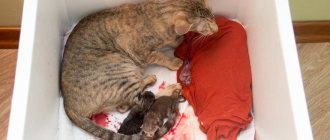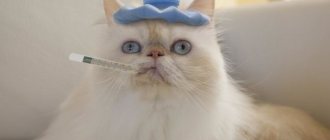Body temperature is one of the main indicators that indirectly indicates the health of a cat. Its significant deviations from the norm require urgent veterinary attention. From the article you will learn what temperature is considered normal depending on the age of the pet, what diseases lead to its increase and decrease, and how to help your four-legged pet at home.
Content
- Normal body temperature in cats
- How to correctly measure a cat's temperature Contact measurement of a cat's temperature step by step
- The main reasons for the rise in temperature
- First aid for hyperthermia
External signs of temperature change
Depending on what temperature the cat is, he may behave and feel in a certain way. The table shows the following common symptoms of hypo- and hyperthermia:
| № | Signs of hyperthermia | Symptoms of hypothermia |
| 1. | Lack of appetite, thirst | Lack of appetite and thirst |
| 2. | Restless state | Lethargy, a state where you can lift an animal by the scruff of the neck like a rag |
| 3. | Excessive sleep | The cat tends to bury itself in warm things or be closer to the heat source |
| 4. | Tremors, convulsions | The wool is ruffled |
| 5. | High pulse, rapid breathing | Low pulse, blood pressure |
| 6. | Digestive disorders | Breathing slow |
| 7. | Watery eyes, runny nose | Paleness of the skin and mucous membranes |
| 8. | Inflammation of the oral mucosa and genital organs |
Reasons for the increase
High temperatures can be caused by serious disturbances in the cat's functioning. Common causes of fever are:
- poisoning;
- infection;
- exacerbation of a chronic disease;
- viral infection;
- poor nutrition.
Any of the factors can lead to serious consequences and even the death of the pet.
Reasons for the downgrade
Most often, hypothermia occurs due to hypothermia in the pet. Spending a long time outside in cold weather or being under air conditioning can lead to this result. This condition can also occur against the background of suppressed immunity. Weakened, after illness or injury, the body stops fighting pathogenic organisms, which leads to a decrease in performance.
In addition, low levels are a sign of problems with the central nervous system, bone marrow pathologies and oncology. This is often how kidney failure and cardiovascular diseases first manifest themselves.
When wondering what temperature is considered low in cats, you should take into account the characteristics of your pet. However, readings below 37 require immediate action.
Normal body temperature in cats
In adult male cats, the normal temperature is in the range of 37.7-39.4°C (average 38.6°C). This indicator may vary depending on age and some physiological characteristics, but does not depend on the breed - hairless and long-haired cats normally have the same temperature.
Table - Temperature of cats depending on age and physiological conditions.
| Healthy kittens up to three weeks of age | 35.6-37.8°C |
| Kittens over 3 weeks old | 38.2-39.8°C |
| Elderly cats and female cats (over 10 years old) | 37.2-38.9°C |
| Pregnant cats | 38.2-39.8°C |
| Females in heat | 38.2-39.8°C |
In nursing cats, the temperature does not differ from normal healthy animals of their age, and any increase in temperature may indicate mastitis or postpartum complications.
How to measure a cat's temperature correctly
You can measure a cat's temperature at home with any thermometer designed for humans - contact (mercury, electronic) or non-contact infrared. The most accurate readings can be obtained using a mercury thermometer, but this method is suitable for animals that are calm about therapeutic and diagnostic manipulations. Readings taken with an infrared thermometer are the least accurate, but non-contact readings are sometimes the only possible way to measure temperature in nervous, restless pets. When using electronic devices, you must carefully study the instructions and strictly follow the instructions.
You can measure your cat's temperature yourself at home.
Contact temperature measurement of a cat step by step
- Shake the mercury thermometer so that the mercury column drops to the lower value, the electronic one just needs to be turned on. Lubricate the tip with Vaseline.
- Temperature is measured rectally with the cat lying or standing. To ensure immobility, the cat is secured by the scruff of the neck. To do this, it is better to invite an assistant who will hold the pet. If the animal resists, it is wrapped in a towel, a light blanket, or secured with a special bag.
- Raise the tail and carefully insert the tip into the anus to a depth of about a centimeter (the anus in cats is located above the vulva, just under the tail). During measurement, you should prevent the cat from trying to sit down - this could cause the tip to break off.
- The mercury thermometer must be held for at least 3 minutes, the electronic thermometer must be held until the sound signal.
- Take out the thermometer and record the readings.
After use, the tip of the thermometer should be washed and thoroughly wiped with alcohol to destroy pathogenic flora. If the tip breaks off and remains in the cat’s body, you should immediately contact a veterinarian. Attempting to remove it yourself can lead to severe intestinal injuries.
To measure temperature with an infrared thermometer, the device is brought to the ear from the inside, without touching it, and wait for a sound signal. During measurement, the cat's head must be fixed.
Measuring the cat's temperature with an infrared thermometer
When is elevated temperature considered normal?
Sometimes high degrees, in a person’s opinion, are not a reason for panic. For example, even experienced cat owners do not always know what the temperature of cats should be during pregnancy. Normally, the expectant mother has a slight increase in indicators, not exceeding a degree.
It is also natural if a cat’s temperature rises within a degree during active play or after suffering stress. In kittens, indicators can change several times during the day - from low during sleep to high after eating or running after a wind-up mouse.
Measuring a cat's temperature is no less important than taking a human's. If you accustom your baby to an unpleasant procedure from childhood, the cat will be less nervous during the process and the owner will have information about the pet’s normal temperature.
Possible causes of hypo- and hyperthermia
Hyperthermia is an increase in body temperature, and hypothermia is a decrease in body temperature. Temperature changes can occur under the influence of cooling or heating of the environment, metabolic reactions in the cat's body. The nervous system is responsible for maintaining normal temperature balance (thermoregulation); central and autonomic disorders can lead to temperature changes.
The main reasons for the rise in temperature
- infectious and inflammatory diseases - panleukopenia, calicivirosis, rhinotracheitis, mastitis, endometritis, cholangitis, pancreatitis, menignitis, abscess and others;
- reaction to vaccination;
- surgery;
- acute poisoning;
- heat damage due to prolonged exposure to the sun, especially in a locked room or car;
- hyperfunction of the thyroid gland (thyrotoxicosis);
- malignant tumor.
Reasons for the decrease in temperature
- hypothermia;
- anemia due to helminth infestation or internal bleeding;
- severe exhaustion;
- thyroid insufficiency (hypothyroidism);
- terminal stage of the disease - cancer, chronic renal failure;
- suffered a serious illness - the temperature may be reduced for several weeks during the recovery period.
With a traumatic brain injury, stroke, or severe stress, body temperature can either increase or decrease.
A cat's temperature is measured rectally using a mercury or electronic thermometer.
Reasons for the drop in temperature
With hypothermia, blood flow is directed to the heart and brain, and in other parts of the body is reduced, resulting in a slower metabolism.
Here are the conditions in which hypothermia begins:
- Hypothermia after being in the cold with high air humidity.
- Weakened state: exhaustion from malnutrition.
- Disruption of internal organs: pathologies of the heart and blood vessels, kidneys and liver, endocrine system.
- Viral infections, if the disease occurs against a background of suppressed immunity.
- Blood loss: occurs after serious cuts, surgical operations, but internal bleeding due to bruises, falls, and illnesses is more dangerous. Owners often do not notice this and do not help the pet.
The owner can know for sure about hypothermia; other causes cannot be identified without veterinary education and special examination.
For what symptoms should you measure your temperature?
An elevated temperature may be indicated by hot ears, nose, and paw pads at rest, accompanied by dryness of the nose and redness of these areas. Its decrease, on the contrary, is accompanied by their unnatural coldness and pallor. If such changes occur, the temperature should be measured. Other indications for this procedure:
- copious and (or) purulent discharge from the mouth, eyes, ears, nose, anus, vagina, penis, sneezing, coughing are signs of infection;
- nausea, vomiting, diarrhea - symptoms of inflammation of the digestive system, helminth infestation, traumatic brain injury, overheating;
- pallor of the skin and mucous membranes – observed in anemia;
- convulsions, tremors (trembling of the paws, head, entire body), loss of consciousness - observed with a strong increase or decrease in temperature for various reasons, neurological or thermal damage;
- loss of appetite, weight loss, lethargy, apathy or, on the contrary, anxiety, agitation - can accompany most diseases.
Sometimes a veterinarian may prescribe daily temperature measurements to monitor the dynamics of the disease and monitor the effectiveness of treatment.
What to do at high and low temperatures
A temporary slight increase in temperature after vaccination or surgery (including castration of a cat, sterilization of a cat) is a normal reaction of the body and does not require veterinary care. Overheating and mild hypothermia can be dealt with independently. You should contact your veterinarian in the following cases:
- with changes in temperature accompanied by signs of any disease;
- with a sharp increase in temperature after surgery;
- with unexplained temperature fluctuations or a stable, prolonged change in temperature without other signs of illness.
Heatstroke, a decrease in body temperature below 32.2°C and an increase above 40°C require emergency contact with a veterinarian. Animals in this condition require intensive therapy, pain relief with narcotic analgesics - normalization of temperature, even with moderate hypothermia, can be accompanied by painful shock.
A temporary slight increase in temperature after vaccination does not require veterinary treatment. help
First aid for a cat at home
Normalizing body temperature does not cure the underlying disease, but improves the pet’s general condition and prevents the development of complications. A critical increase in temperature changes leads to damage to vital organs and systems and disruption of their functions. At home, before visiting a doctor, you can only use physical methods to lower or raise the temperature - cooling measures and warming, as appropriate.
It is unacceptable to lower your cat's temperature with medications on your own.
Antipyretic drugs, which are practically safe for humans, can lead to intoxication of the cat’s body, so their use is possible only as prescribed by a veterinarian. It is strictly forbidden to treat a cat with antipyretics and painkillers of the anilide group (paracetamol, Panadol, Tylenol, Efferalgan, acetaminophen and others) - they lead to severe hematopoietic disorders and the death of the animal.
First aid for hyperthermia
Cooling measures are required for cats with temperatures above 39.4-40°C; at lower temperatures they can lead to hypothermia. In case of heat injury, one of the most effective methods of cooling is wetting the fur and then placing the animal under a powerful fan. You can alleviate the condition at elevated temperatures with ice packs - they are applied to the inner surface of the thighs and neck. This method is convenient for emergency transportation of a pet to a veterinarian. If there is no constipation, diarrhea, or acute abdominal pain, cold water enemas will help reduce the temperature. Another way to eliminate hyperthermia is to wet the paw pads with alcohol.
Ice covering the entire body and general cold baths are not recommended. They cause a narrowing of peripheral vessels, which contributes to the flow of “overheated” blood to the internal organs and their further damage.
If the temperature drop is insignificant, it is enough to wrap the cat in a blanket
First aid for hypothermia
For a cat with a slight (up to 32.2°C) decrease in temperature without signs of exhaustion, it is enough to wrap it in a blanket, after drying the wet fur with a towel or hairdryer. If the animal is exhausted or the previous method is ineffective, warm air is blown under the blanket with a hairdryer, and it is better to wrap the animal’s head as well. With a more pronounced decrease in temperature, the animal is covered with bottles of warm water and taken to the clinic.
If a cat that has been exposed to the cold for a long time does not show signs of life, it should be examined by a veterinarian - during an amateurish examination, a living pet in this state is often mistaken for dead. Cats with severe hypothermia should be transported to the clinic carefully, protecting them from shocks - even the slightest mechanical impact can lead to cardiac arrest and death.
In kittens under 3 weeks of age growing up without a mother, their body temperature drops even when kept in a relatively warm room - their body is able to maintain a temperature only 5-7°C above the environment. The nest of such babies should be kept warm at least 29-32°C. The space inside the box can be heated with lamps, hot water bottles wrapped in a towel.
Learning to measure a cat’s temperature and knowing what its changes may be associated with is important for every owner who loves their pet. This will help the doctor quickly determine the diagnosis, adjust treatment in time and maintain the health of the animal.
What temperature is considered critical?
The critical level is 37C and 40.5C. This temperature is a clear sign of illness and problems in the animal. But what signs accompany all this? The simple method of touching the nose will not help because it is false.
Symptoms of elevated temperature:
- Refusal of food and water.
- The pulse rises to 200 beats per minute. The norm is 150 beats per minute.
- The mucous membranes become inflamed.
- He hides and sleeps longer than usual.
- Vomiting or loose stools are common.
- In the worst cases, the animal begins to become exhausted.
Symptoms of low temperature:
- Lethargy and weakness are noticed, the cat begins to tremble due to fever.
- Sleeps more than usual, begins to hide in warm places and refuses to leave them.
- The wool stands on end to further retain heat.
- Heart rate and breathing slow down.
Kitty











